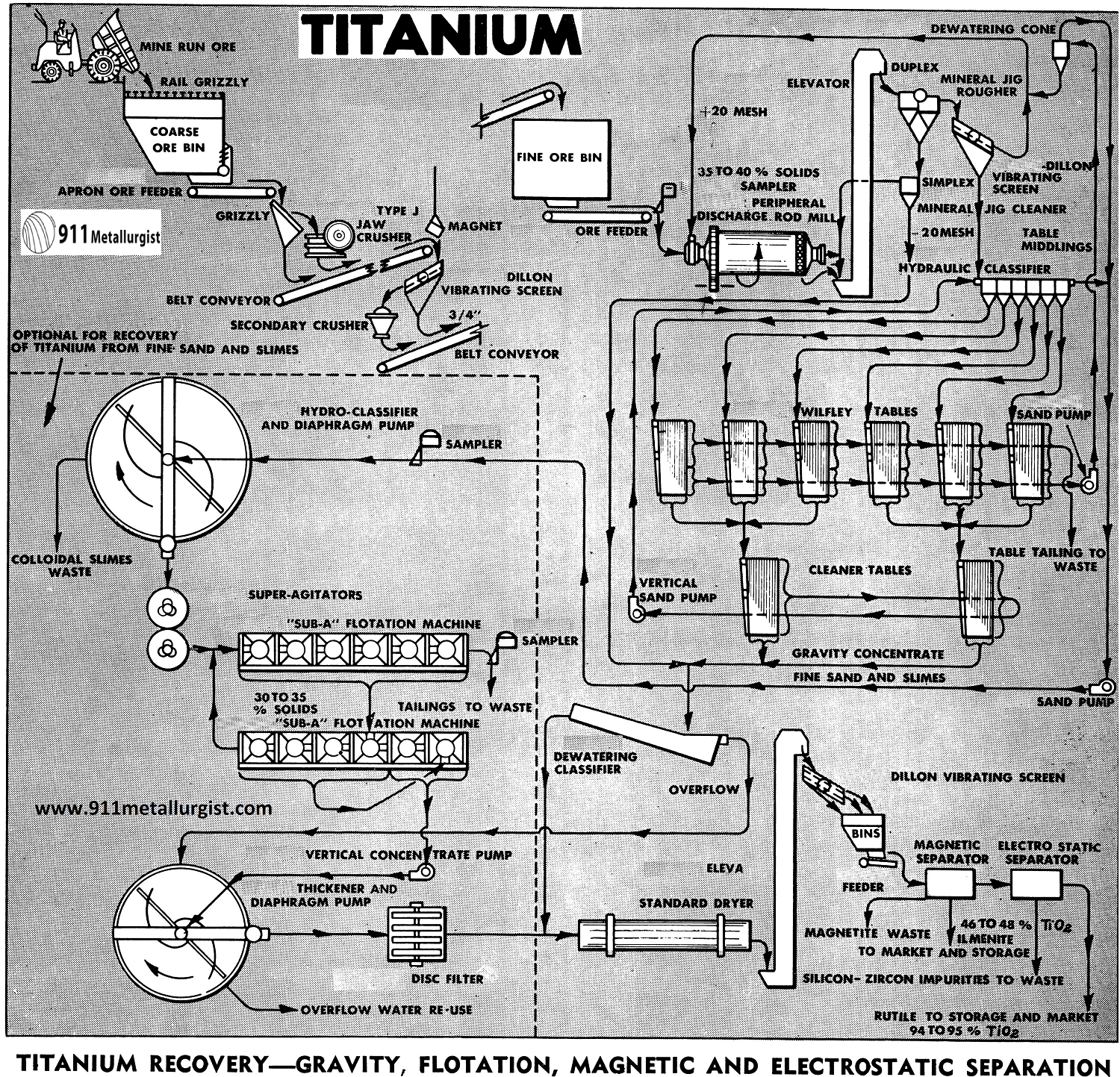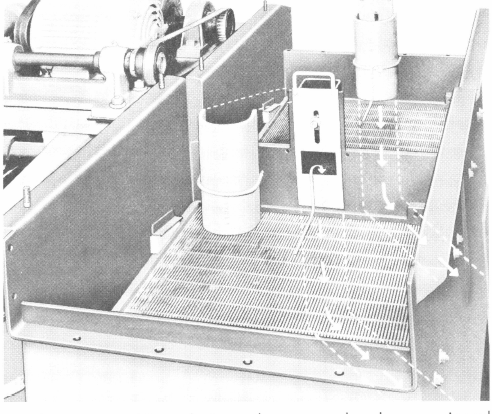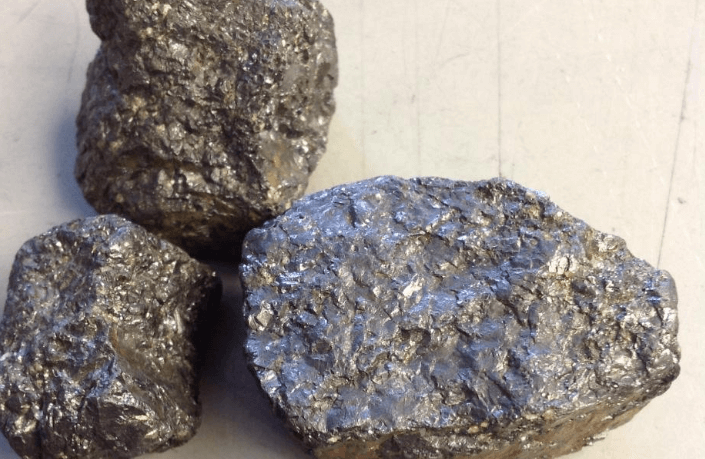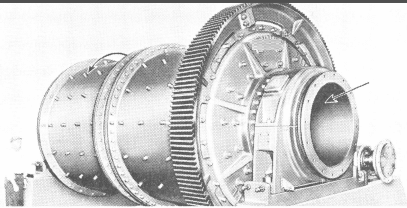Table of Contents
To develop a flowsheet for separation of high grade titanium-rutile from ilmenite, that will meet market requirements. Rutile has a SG of 4.2, hardness 6.0 to 6.5 and is non-magnetic; while ilmenite has a SG of 4.5 to 5.0, hardness of 5.0 to 6.0, and is weakly magnetic. Both minerals are amenable to gravity concentration.
Titanium, “the miracle metal,” is a development resulting from the atomic and jet propulsion age. It is lighter than steel and stronger than aluminum, and has an almost unequaled resistance to corrosion. Titanium, a high-strength structural material has a corrosion- fatigue behavior in salt water, and exhibits complete immunity to many chemicals that pit and deteriorate most other metals. Its chief demands are as the metal in alloys, with a significant consumption as a white pigment in the paint industry. The value of titanium in sponge form is presently worth $9 to $10 a pound; in plate and sheet is 2 to 3X that.

Titanium Ore Extracting Flowsheet
The flowsheet shown was developed for a mixed rutile and ilmenite ore containing some magnetite. Concentration in this typical case starts at about 10 mesh and continues on into the minus 200 mesh fines. Gravity concentration starting as coarse as possible is very important in the recovery of a mixed ore of rutile and ilmenite, for a granular slime free product is much more amenable to subsequent magnetic and electrostatic separation. In any grinding circuit slimes are produced; if tonnage is considerable, flotation should be incorporated in flowsheet.

Duplex Mineral Jig makes a rougher heavy mineral concentrate
Crushing of Ti Ore
Conventional two stage open circuit crushing reduces the ore to about ¾” which is good feed to the rod mill. Sometimes a closed circuit reduction becomes necessary to ensure all minus ¾” or finer feed to the grinding circuit. Nature of the ore and its moisture content are factors considered in choosing circuit to be used.
Grinding and Coarse Concentration
¾” crushed ore passes through a peripheral discharge Rod Mill at high dilution (35 to 40% solids). This minimizes over-grinding and sliming of the feed particles of titanium. The peripheral discharge product from the rod mill is elevated to a Duplex Mineral Jig making a rougher heavy mineral concentrate for retreatment in a Simplex Mineral Jig. The gravity flow through the jigs and Dillon Vibrating Screen returns the plus 20 mesh oversize to the rod mill for regrinding. This circuit recovers 40 to 50% of total titanium in a high grade granular product, ideal for magnetic and electrostatic separation.
Hydraulic Classification and Tabling
The —20 mesh screen undersize is sized in a Hydraulic Classifier for most efficient tabling. Wilfley Tables with sand riffles handles the coarser sizes, while the finer sizes are handled on decks properly riffled for fine sands. This produces higher grade concentrates, maximum recovery and gives best table operation. Rougher table concentrates are cleaned on two separate tables, equipped as on the rougher table circuit. Cleaner table middlings are returned to the hydraulic classifier while the rougher table middlings go to the grinding circuit after being dewatered in a centrifugal cone, getting rid of the excess dilution. Gravity concentrates are flumed to a Dewatering Classifier. Hydraulic classifier overflow containing slimes and fines from the middling circuit overflowing the centrifugal classifier are thickened prior to waste or treatment by flotation.

Peripheral discharge Rod Mill receives ¾” crushed ore. Grinding under high dilution (35-40% solids) minimizes over grinding and sliming of fee particles of titanium. The fraction from the rod mill is elevated to a Duplex Mineral Jig.
Flotation of Titanium Fines
The -10 micron slimes go to a thickener, purposely selected undersize to overflow the colloidal slimes, or through a Hydraulic Classifier to reject the colloids in the overflow. The deslimed cone underflow-density 65-70%—goes to conditioner and flotation cells.
High density conditioning in a slightly acid circuit, pH 6.0 to 6.5, with H2SO4, sodium fluoride, and oleic acid actuates the titanium minerals for rapid flotation. This computation effectively rejects the gangue minerals and any apatite. Flotation is in “Sub-A” Flotation Machines with 30-35% solids with fuel oil and a frother added as necessary. The rougher concentrates are cleaned in an acid proof “Sub-A” Machine, by adding H2SO4 to lower pH to 5.0-5.5, which rejects gangue minerals and all phosphate minerals, to not more than a trace. Flotation cleaner middlings are recirculated to the rougher circuit for dilution.
Filtering and Drying
Flotation concentrates are thickened and filtered; gravity concentrates are dewatered by a classifier, pan filter or internal drum filter. Concentrates are thoroughly dried, removing all surface coatings, and is done by conditioning the concentrates with chemicals to cut and wash off the surface film of soap and oils or blowing them off in a dryer.
Magnetic and Electrostatic Separation
Concentrates containing rutile, ilmenite, magnetite, zircon and possibly silica are sized over a vibrating screen and collected in separate storage hoppers ahead of dry processing, as each size is treated separately.
Low intensity magnetic separation pulls out metallic iron and magnetite. The concentrates pass through a high intensity magnetic separator to pull out the ilmenite fraction—46 to 48% TiO2. The non-magnetic fraction is subjected to high intensity electrostatic separation which removes the high grade rutile—94-95% TiO2. Rejects are treated by flotation to recover the zirconium.
Possibilities For All Flotation Treatment of Titanium Ore
Generally on complex titanium ores it is advisable to use the combination flowsheet shown. An ore of magnetite and ilmenite may, however, employ wet magnetic separation to remove magnetite, and all flotation for recovery of the ilmenite in a high grade product. In this case all the gravity circuit including the jigs and tables can be eliminated. This scheme is also applicable on a rutile ore with little or no ilmenite. Generally on complex titanium ores it is advisable to use the combination flowsheet shown. An ore of magnetite and ilmenite may, however, employ wet magnetic separation to remove magnetite, and all flotation for recovery of the ilmenite in a high grade product. In this case all the gravity circuit including the jigs and tables can be eliminated. This scheme is also applicable on a rutile ore with little or no ilmenite.
Source: This article is a reproduction of an excerpt of “In the Public Domain” documents held in 911Metallurgy Corp’s private library.
